The point of a gaming chair is to support good posture over long periods of sitting. As you get used to healthy sitting, you’ll gain greater awareness of your body and its workings. That will spread to an expanded awareness of your surroundings as well. Take advantage of that using feng shui design fundamentals. These logical, intuitive steps can supercharge a workspace with positive, invigorating energy.
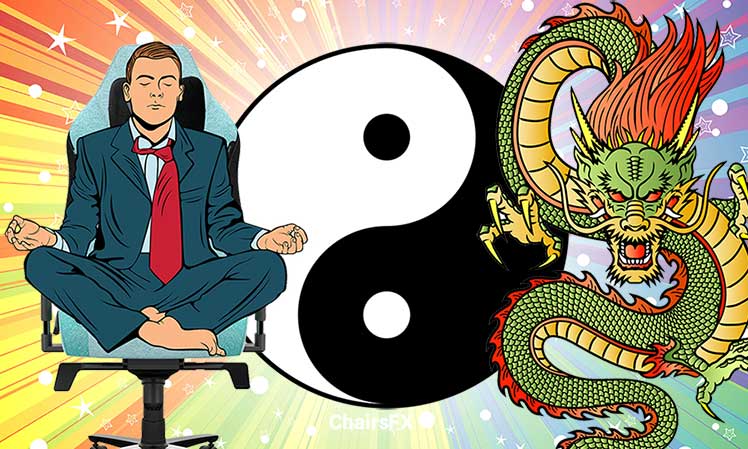
“Feng shui” is a Chinese phrase. Its literal translation is “wind” (feng) and “water” (shui). In design, feng shui refers to the art of arranging living and working spaces for harmony and balance.
It’s an ancient practice packed with complex nuances. Even so, the basic principles are intuitive and easy to connect with. The point is to maximize the flow of positive energy in a space. Applying these to your workspace can make you feel happier, more energetic, and a lot more productive.
Feng Shui Design Fundamentals
By modern scientific standards, feng shui principles are unmeasurable pseudoscience. From a cultural perspective, it’s a traditional art that has been practiced and passed on over thousands of years.
Feng Shui started in China around 3,000 years ago as a way to position graves. It was important to site graves so they were not affected by floods, typhoons, or high winds.
Its concepts are based on the I Ching (written in China around 800 BCE). According to that book, everything in existence is created by Yin or Yang.
These opposing forces generate energy in four directions: north, east, south, west. Within each, natural phenomena like wind and water can create different effects.
Part 1: Assess A Room’s Orientation
The first step in any feng shui makeover is to assess the orientation of your workstation. That will give you a sense of the room’s ying-yang balance.
Yin represents a dark, feminine, receptive principle. Yang is light, masculine, and active. Within interior spaces, the goal is to balance the two energies.
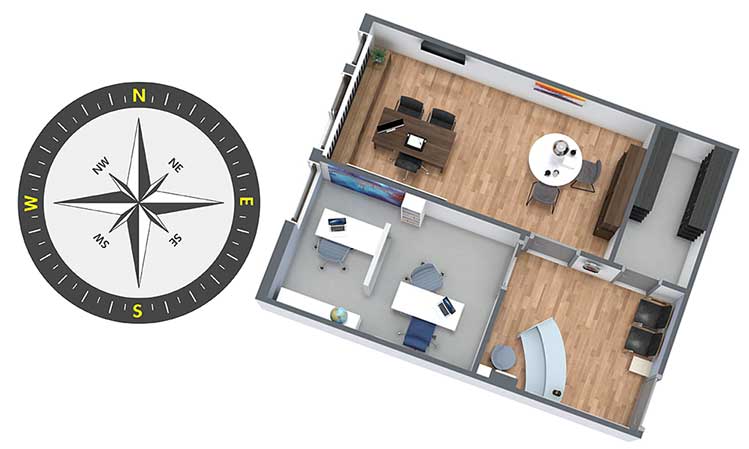
You can achieve this with a compass app on your cell phone. Simply find out which direction in your room points north, east, west, and south.
Hard-core practitioners do this with a feng shui compass. This has an inner ring made of eight trigrams (ba-gua). Each symbolizes a part of the natural world: Heaven, Earth, Fire, Water, Lake, Mountain, Wind, Thunder. Each side of the eight-sided map corresponds to an area of life experience.
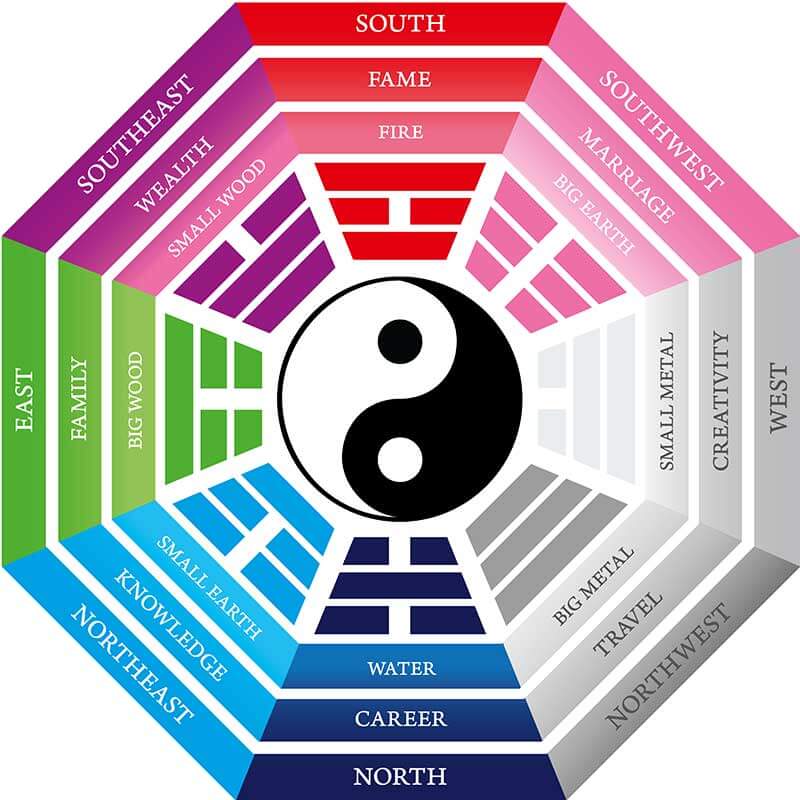
The four basic directions are north, east, south, and west. That splits into eight directions (north, northeast, east, southeast, south, southwest, west, northwest).
The eight directions split further into 24 mountains. These divide 360 degrees by 24 points. Each of the 8 basic directions divide into three ranges. As a result, you have , South 1, South 2, South 3, North 1, North 2, North 3, etc.
Summary: use a compass to determine the cardinal directions of your room’s front door, your desk, windows, and furniture. Use that data as a guide to balance energies governing peace of mind, clarity of thought, and happiness.
Part 2: Assess Elements in the Room
Within the feng shui compass, there are five elements. Take stock of your workspace to determine what elements it contains.
- Wood: harnesses the power of creativity and expansion. It represents traits like growth, strength, flexibility, and intuition. Too much wood makes a person rigid, stubborn, and inflexible. Too little can show up as apathy, depression, or a lack of creativity.
- Fire: in a workspace, lighting represents this element. Fire elements boost enthusiasm and leadership skills. Incorporate these to encourage bold expressiveness and inspiration. Too much fire manifests as anger, aggression, and impulsive behavior. Too little generates emotional coldness and a lack of self-esteem.
- Earth: makes people feel grounded, balanced, and stable. Too much earth yields boredom, seriousness, and sluggishness. Too little breeds a lack of focus and chaos.
- Metal: affects mental clarity and logic. It promotes organization, focus, and analytical prowess. Too much makes a person overly chatty and critical. Too little generates cautiousness and a lack of focus.
- Water: influences spirituality and emotions. In balance, water brings inspiration, wisdom, and insightfulness. Too much can create overly social energy and a feeling of emotional drowning. Too little encourages a lack of sympathy, loneliness, isolation, and pettiness.
Part 3: Balance The Five Elements
Everything in heaven and on earth is a constant interplay among the five elements. As a result, a key point in Feng shui is to keep the elements in balance.
Each piece in a workspace represents an element (desk, lights, flooring, chair, accessories, etc). The feng shui objective is to create a balanced blend of all five elements for a harmonious environment.
Balancing elements is a deep and complex art. In simple terms, one achieves balance by applying nurturing, controlling, or reducing principles.
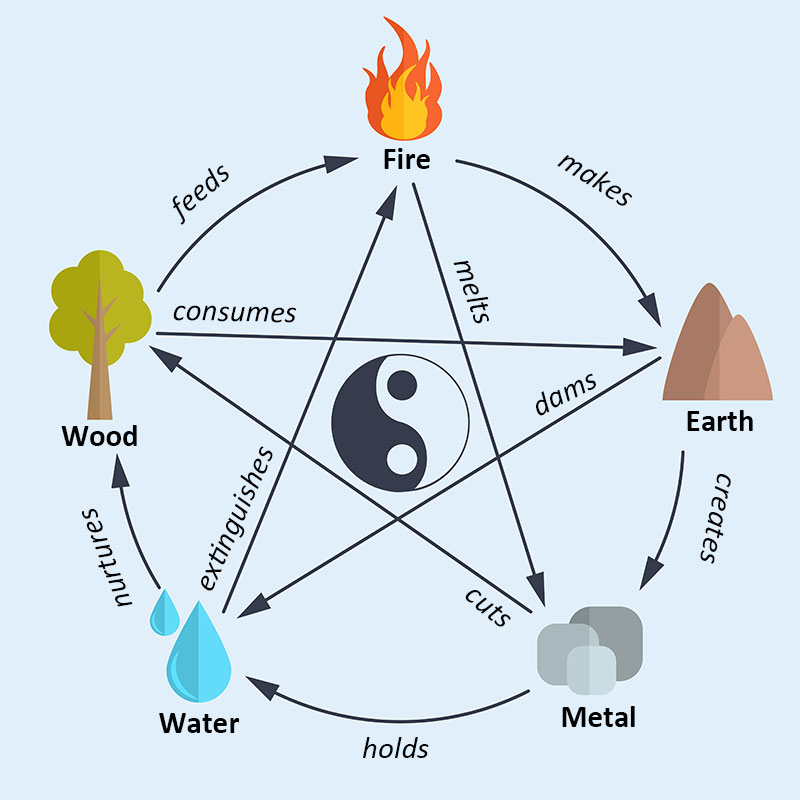
For instance, fire nurtures earth. After fire burns, the resulting ashes add more earth crust. Metal nurtures water by containing it in vessels.
For controlling elements, fire controls metal by melting it. Wood controls earth by planting roots. Earth controls water with dams and dikes. Water controls fire by extinguishing it.
In the reducing cycle, fire burns wood. Water corrodes metal. Metal gets mined out of the earth. Earth suffocates fire.
WELL Building Standards Checklist
Even with a firm grasp of the basics, feng shui is very abstract. To bring the essentials into sharper focus, it helps to compare them with the WELL Building Standard.
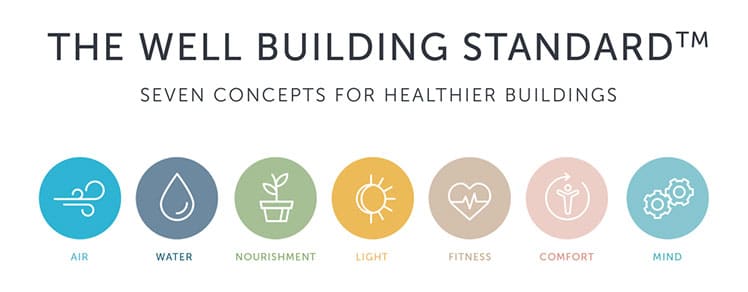
This is an international standard for creating productive and comfortable working environments. At its core are seven principles that make feng shui principles more coherent:
- Air: this study found an 11% increase in workspaces with clean, fresh air. In your home office, work to reduce pollutants and increase fresh air.
- Water: our brains are 73% water. Keep a water flask at your desk to stay hydrated throughout the day. Try to limit (or abstain from) coffee, energy drinks, and sugary sodas.
- Nourishment: avoid junk food and alcohol. Eat clean food.
- Light: a Cornell study found that sitting within 10 feet of a window has a positive effect. The study found an 84% reduction in eyestrain, headaches, and blurred vision symptoms.
- Fitness: esports players sit full-time for 10-12 hours every day. But they also compete for millions in prizes at global esports tournaments. They need to stay sharp. Take inspiration from pro esports players. Give yourself an edge with regular exercise.
- Comfort: your office space should be a comfort zone. Using the right chair is the key. That will reduce muscle fatigue and increase productivity.
- Nature: this study found that adding nature to a workspace caused a 15% wellness boost. Add some houseplants or a small fish tank to get your groove on.
Feng Shui Home Office Supercharge
Ambiance optimization is step 4 in our 6-Step Home Office Productivity Supercharge Plan. The first step involves investing in a good ergonomic chair. The second is to use your chair correctly to optimize your posture.
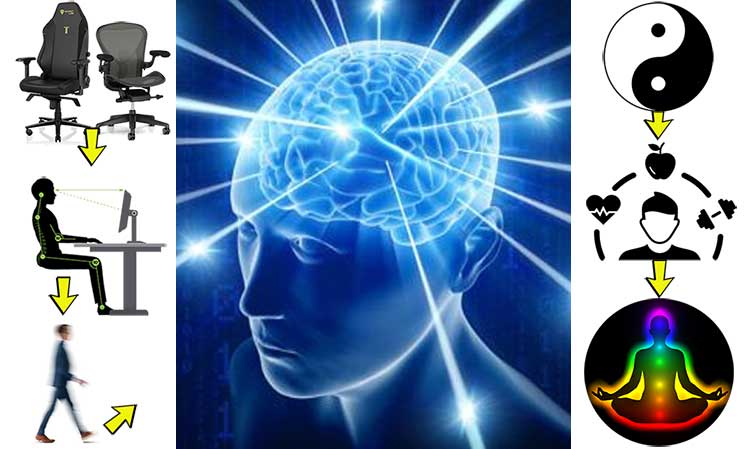
With good sitting posture ingrained, you’ll feel more energetic, optimistic, and focused. As part of that process, you’ll also gain a greater awareness of your body and its surroundings. When that kicks in, you can ride its momentum towards added enhancements.
This section combines feng shui basics with WELL Building Standards. That presents a coherent plan to swell up your workspace with positive, invigorating energies.
Step 1: Maintain A Clean Workspace
The end goal of feng shui is to increase happiness. At a desk, the first step to achieving that is cleanliness. Many studies show that working in unkempt spaces increases stress and anxiety levels. That inspires unhealthy coping mechanisms like overeating.

It also restricts the brain’s capacity to concentrate and process information. As a result, productivity crumbles. In contrast, a clean workspace yields several benefits.
For desk workers, the most important benefit is improved productivity. While clutter distracts, a clean workspace sharpens focus. As a result, you’ll be able to get more work done in less time. That gives you more time to pursue healthy lifestyle habits.
Start by clearing any clutter off the floor. Do the same on your desktop. Give your computer, keyboard, screens, and desktop a good wipe-down. After that, set a goal of starting every workday at a freshly cleaned desk.
Step 2: Place Desk In The Power Position
Most people choose a wooden or metal desk for a home office or gaming station. In feng shui, metal conveys precision, simplicity, and clarity. In comparison, wood exudes natural, nourishing energies. Choose the effect that connects with your sensibilities.
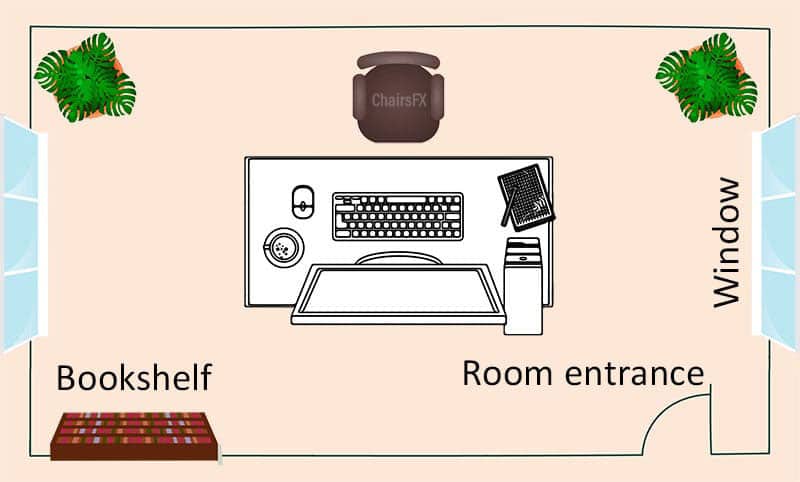
Whichever type you select, its layout without a room makes a difference. If possible, arrange your layout to meet two objectives:
- Desk faces door: facing the entrance is a room’s power position. Sitting in the power position stimulates success energies. In contrast, sitting with your back to the door generates anxious, vulnerable energies.
- Windows to the sides: a window in front of your desk flows your energy past the desk and out the window. A window behind your desk lets chi (life energy) escape. That raises feelings of vulnerability.
Step 3: Balance Room Elements And Colors
Many studies show how different colors produce unique effects in humans. Specifically, different colors send different wavelengths of information to the brain. These get decoded in the hypothalamus. That part of the brain governs body temperature, heart rate, appetite, and more.
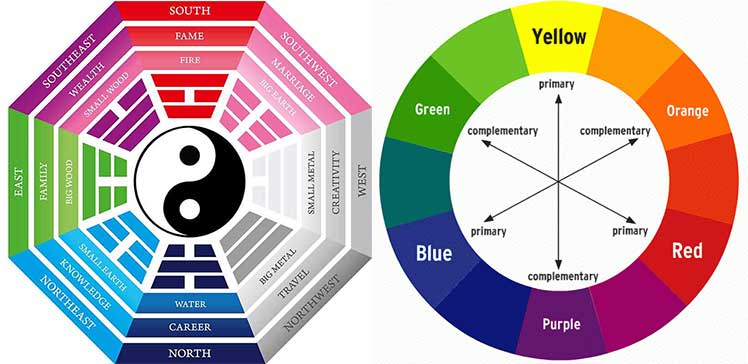
Within a feng shui context, color is one of the easiest tools available to adjust a room’s energies. One method is to plan colors using a feng shui compass. Alternatively, a classic graphic design color wheel can also help.
Color Theory Within a Chair Context
At ChairsFX, our knowledge of color theory has come from testing out different gaming chairs. FOr example, Secretlab makes fabric gaming chairs in six colors. Our Secretlab fabric gaming chair review breaks down the effects of each color.
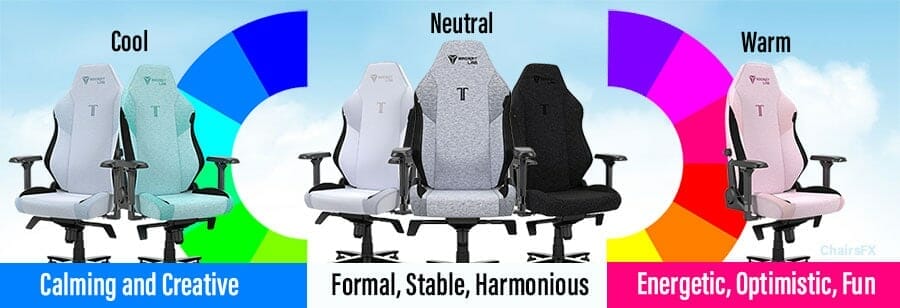
To get a grip on color theory, we arranged all six chairs within the color spectrum. In sum:
- Neutral colors: used as standard in office designs. These slow the heart rate. They also stimulate a sense of formality, harmony, and blending in.
- Cool colors: blues and greens recall nature. Interior designers use cool colors to stimulate calmness, creativity, and deep thinking.
- Warm colors: these reflect more light and energy. Bright reds and yellow stimulate the appetite. Warm hues are staples in fast food branding. They’re known to stimulate appetites and exude a fun, energetic dynamic.
Step 4: Optimize Your Lighting
Light represents the fire element. It serves as the strongest manifestation of feng shui energy. Natural light stimulates circadian rhythms. These are biomechanical changes that follow a 24-hour cycle.
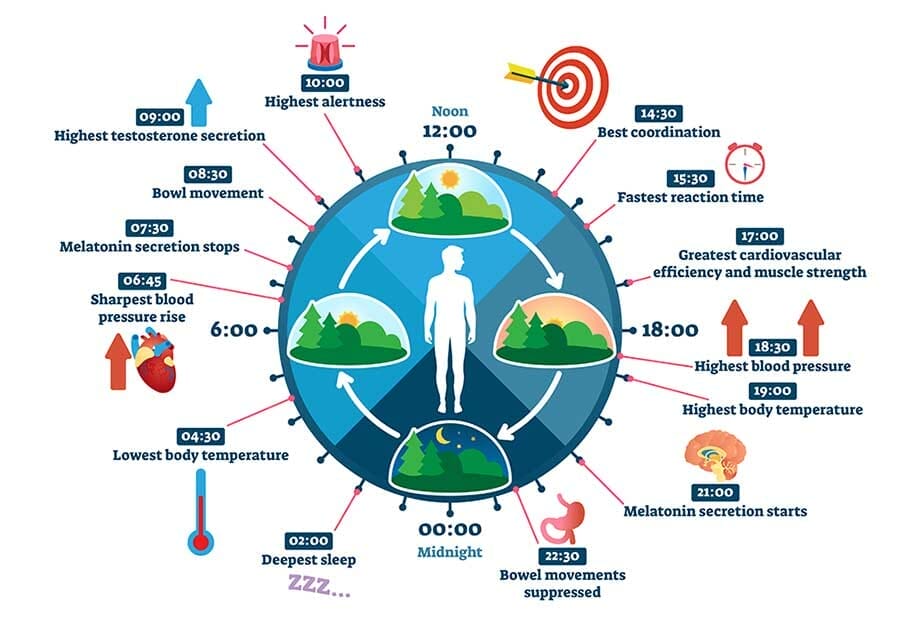
Circadian rhythms are biomechanical changes that follow a 24-hour cycle. These get triggered by light and dark and affect most living things. Circadian rhythms influence eating habits, digestion, hormone release, and sleep cycles.
For instance, when the sun sets, less light hits the optic nerves. That information triggers the brain to produce more melatonin which induces drowsiness.
Working under artificial lights disrupts the circadian clock. This disruption has been linked with depression, metabolic disorders, immune diseases, and cancer.
Problems With Conventional Lighting
Incandescent and fluorescent light bulbs are inefficient and bad for the environment. LEDs work better but can cause blue light overload issues. Key issues:
Inefficiency
Old-school incandescents emit the same quality of light as fire, the sun, and the stars. However, they consume too much energy. Fluorescents are more energy-efficient, but harder on the eyes. These days, most places use LEDs.
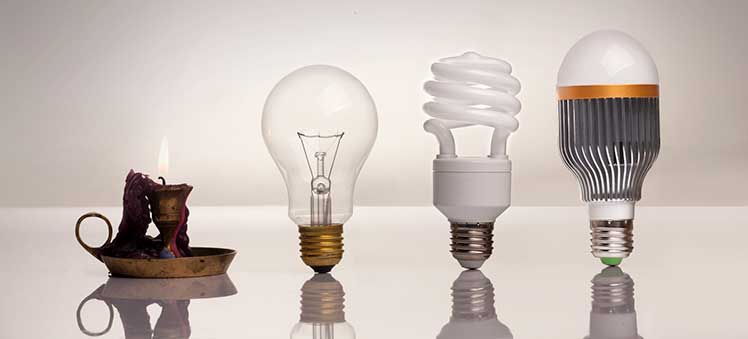
- Incandescent: produces a warm continuous spectrum that resembles natural light. Not energy efficient.
- Fluorescent: good energy efficiency; mediocre eco-friendliness. Produces a flickering spectrum of mainly blue wavelengths. Full-spectrum variants are also available (good for growing houseplants).
- LED: next-level energy efficiency. Emits only one color at a time (usually blue).
Fluorescents contain lead and mercury, while LEDs are eco-friendly. LEDs also last longer and consume less energy. The problem with both is that they bathe computer users in too much blue light.
Blue Light Overload
Blue light is a part of the visible light spectrum. Around 25% of sunlight is blue light. During the day, that spectrum triggers the brain to suppress melatonin levels. As the sun sets, the trigger fades. That signals melatonin production to kick in.
Working under artificial lighting disrupts that cycle. Beyond disrupting sleep patterns, it can also cause eye discomfort, headaches, and even long-term eye damage.

Solution: Smart LED Lighting
LEDs are the brightest, most energy-efficient, and most eco-friendly. Excess blue light is its drawback. A Smart LED overcomes that limitation.
Effective Feng Shui lighting balances yin (calm) and yang (lively) energies. Using a smart LED, you can do so by perfectly syncing your lighting with your circadian rhythms.
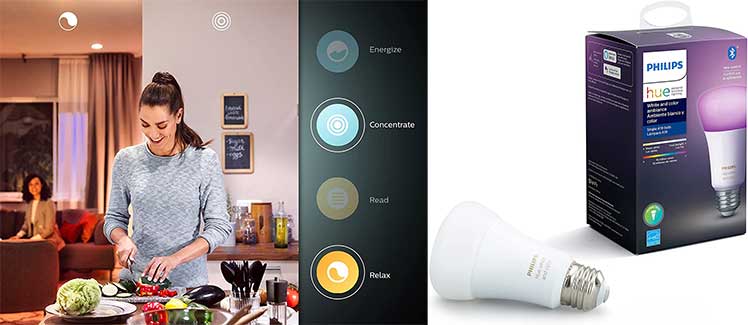
On Amazon, the Philips Hue is one of the best-selling smart LEDs. It’s a 60W bulb with 16 million colors and built-in Bluetooth. Use that to connect with a phone app.
The app lets you customize the quality of light throughout a workday. Early in the morning, set it to emit cool white light. In the afternoon, tone things down with warmer red hues.

This tweak is a no-brainer. For one thing, it will lower your energy costs while emitting a stronger quality of light. For another, it’s an easy way to sync your workspace with circadian rhythms.
Step 5: Energize The Room With Fresh Air
Fresh air is an essential part of a vibrant workspace. From a feng shui context, fresh air clears stagnant energy and restores chi in an environment.
On a physiological level, fresh air reduces stress levels, boosts energy levels, and enhances concentration.
If not possible to open windows, add plants to help clean the stale air. Areca Palms, Lady Palms, and Rubber Plant are good air cleaners.
Step 6: Manage Sound And Noise Pollution
Sound energy comes from vibrations that travel through air, water, or matter. This generates vibrations that can disrupt the energy balance in your workspace.
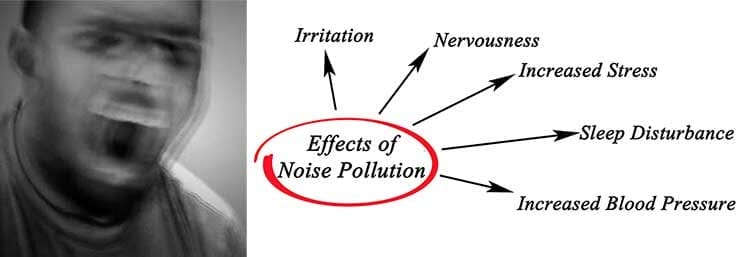
Sudden noises or auditory inconsistencies create a jarring effect (dogs barking, banging hammers, etc). This can shatter concentration and rattle nerves. That disrupts the harmony and flow of chi through a room.
Sound Masking With White Noise
You can’t control barking dogs, tap-dancing neighbors, or jackhammer construction. However, you can drown those sounds out with white noise.
White noise combines all frequencies in the auditory spectrum. It plays as random, continuous noises that mask other sounds.

A whirring fan, humming air conditioner, and television static all qualify. On Youtube, there are dozens of 10-hour white noise videos with the sounds of streams, rainfall, ocean waves, etc. In my experience, any running water sounds without birdsong can do the job.
ChairsFX Foolproof Sound Masking Solution
I’ve been using a foolproof white noise solution for a few years. It drowns out construction, barking dogs, crying kids, and the tap-dancers living upstairs from me.
Any running water sounds will do, although I prefer white noise waterfalls. Even at high volumes, the sound of running water is instantly relaxing. From a feng shui perspective, water sounds recall nature and add tranquility to a room.
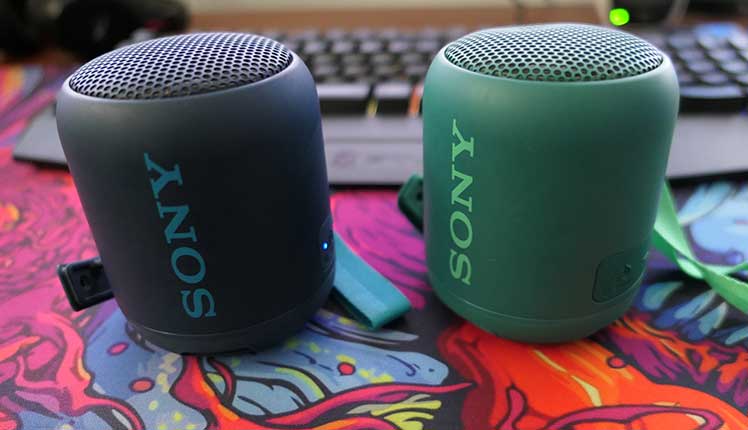
To deliver the sound, I’ve enjoyed great success with a pair of Sony SRS-XB12 Mini Bluetooth Speakers. One unit serves as a powerful Bluetooth speaker with heavy bass and 16-hour battery life. If you add another speaker, you can pair them to create a stereo effect.
To completely drown out noise, this works every time:
- Connect two SRS-XB12 speakers to your phone. Then, pair the two speakers together into stereo mode.
- Fire up a white noise waterfall video (or mp3) on your cell phone.
- Place the speakers closest to the noise source. If noises are all around, place each speaker at opposite sides of the room.
Follow these steps to drown out unwanted noise while bringing feng shui water elements in your workspace.
Conclusion
To follow through with the steps in this guide, you need two things. First, an awareness of your body in relation to its surroundings. Second, the motivation to improve the conditions of both.

In our 6-Step Home Office Supercharge Guide, feng shui optimizations are step 4:
- Buy a good gaming chair or ergonomic office chair.
- Learn how to use the chair to optimize your posture.
- Incorporate movement breaks into your routine.
- Optimize your ambiance using feng shui.
- Develop good nutrition, exercise, and sleep routines.
- Maintain the discipline to hold to these habits.
For best results, start with Step 1 and work your way up. By the time you reach Step 4, your sitting posture will be on-point.
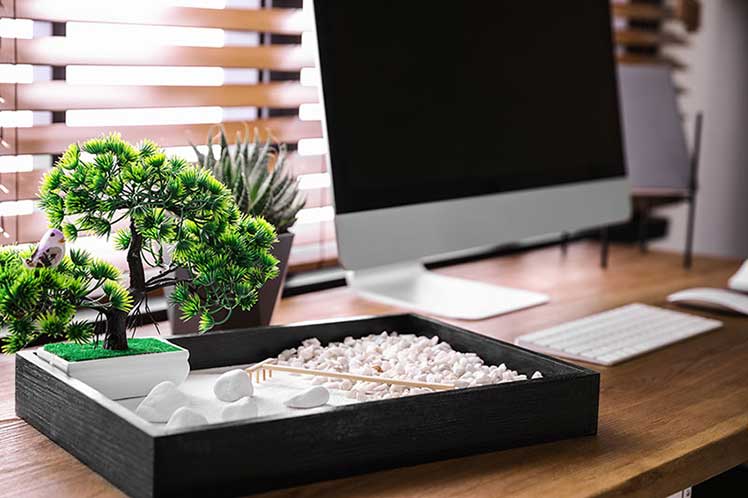
As a result, you’ll gain greater awareness of your body and its surroundings. Once that kicks in, follow the steps in this feng shui guide to supercharge your workstation:
- Maintain a clean, clutter-free workspace.
- Position your desk facing towards the room’s main entrance.
- Balance the colors and elements in the room.
- Sync lighting to circadian rhythms using a Smart LED.
- Energize the room with regular influxes of fresh air. If fresh air isn’t possible, use houseplants.
- Manage sound disturbances using white noise sound masking.




